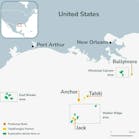The US light, sweet crude oil contract for October settled flat on Sept. 15 at $49.89/bbl, unchanged from the previous day, after alternating between gains and losses throughout that day’s trading session.
The contract opened at $49.72/bbl and fluctuated between a high of $51.13/bbl and low of $49.41/bbl before closing.
Giovanni Staunovo, UBS Wealth Management analyst said, “Sentiment has completely changed” to the upside for oil prices within the past month, adding, “Demand is now stronger than supply.”
The US Energy Information Administration forecast world energy consumption will rise to 736 quadrillion btu (quads) in 2040 from 575 quads in 2015, an increase of 28%. The forecast came in EIA’s latest International Energy Outlook 2017 (OGJ Online, Sept. 14, 2017).
Separately, the US rig count ended the week of Sept. 15 with its largest weekly decline since the end of the drilling dive of late-2014 to mid-2016.
Baker Hughes’ tally of active rigs fell 8 units to 936. Of those 8 rigs, 7 drilled for oil. The gas-directed rig count was 186. One rig considered unclassified remained drilling (OGJ Online, Sept. 15, 2017).
Energy prices
The November delivery contract for light, sweet crude on the New York Mercantile Exchange gained 9¢ Sept. 15 to settle at $50.44/bbl.
The NYMEX natural gas price for October fell 4.6¢ to $3.02/MMbtu. The Henry Hub cash gas price declined 5¢ to $2.99/MMbtu.
Heating oil for October gained 2¢ to a rounded $1.80/gal. The NYMEX reformulated gasoline blendstock for October was up 3¢ to $1.66/gal on Sept. 15.
The Brent crude contract for November on London’s ICE rose 15¢ to $55.62/bbl. The December contract climbed 20¢ to $55.42/bbl. The gas oil contract for October was $534.75/tonne, up $3.75.
The Organization of Petroleum Exporting Countries’ basket of crudes for Sept. 15 was $53.64/bbl, up 1¢.
Contact Paula Dittrick at [email protected].

Paula Dittrick | Senior Staff Writer
Paula Dittrick has covered oil and gas from Houston for more than 20 years. Starting in May 2007, she developed a health, safety, and environment beat for Oil & Gas Journal. Dittrick is familiar with the industry’s financial aspects. She also monitors issues associated with carbon sequestration and renewable energy.
Dittrick joined OGJ in February 2001. Previously, she worked for Dow Jones and United Press International. She began writing about oil and gas as UPI’s West Texas bureau chief during the 1980s. She earned a Bachelor’s of Science degree in journalism from the University of Nebraska in 1974.
